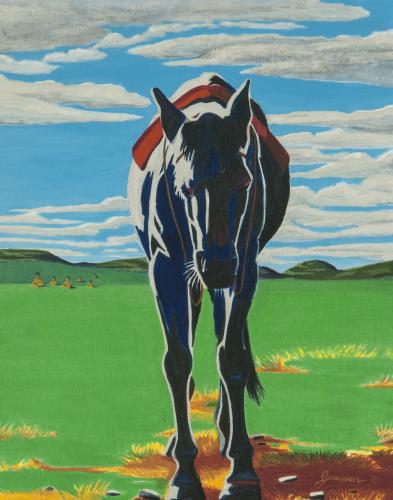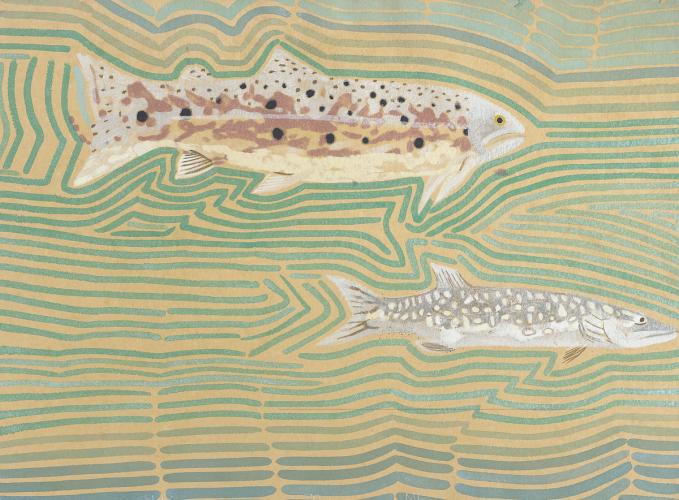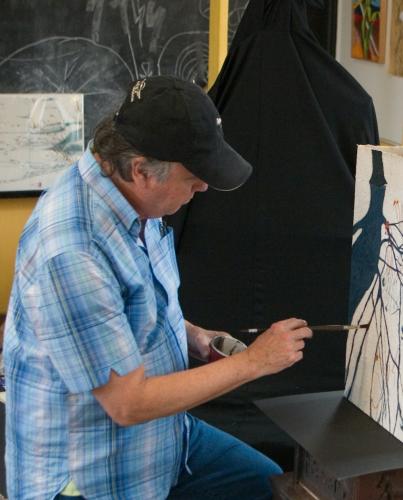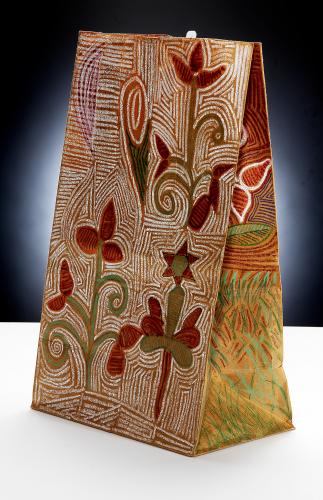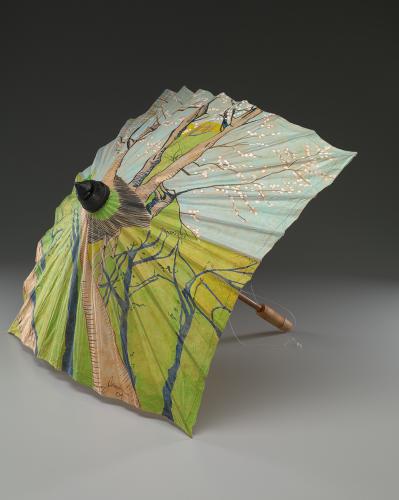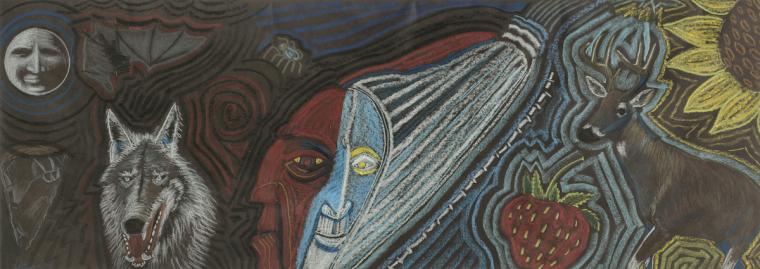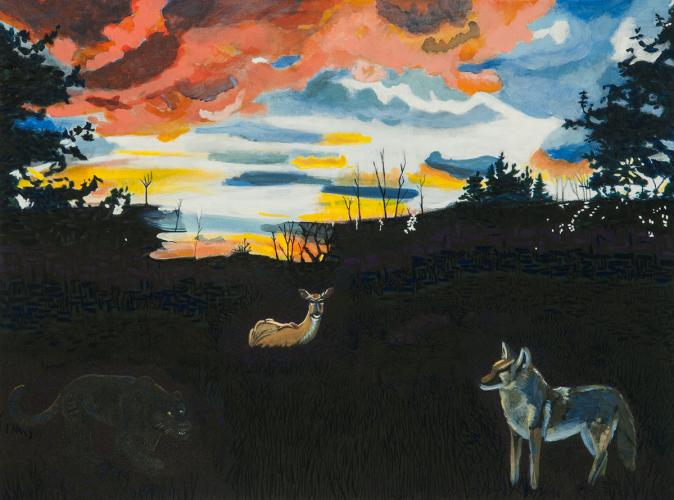A steel car bridge once crossed the Cattaraugus Creek that separates the Seneca Nation’s Cattaraugus Reservation from the largely non-Native border hamlet of Irving in western New York state. As a youth, G. Peter Jemison (Seneca, Heron clan) walked across it many times. Then, 15 years ago, the bridge came down. Viewing the gap between the two worlds, Jemison recalls thinking, “Now I am the bridge.”
During his long career as an artist, educator, curator and self-described “culture worker,” as well as a trustee of the National Museum of the American Indian, Jemison has conveyed Seneca tradition and history to a broad audience. In fact, this summer, one of his paintings is scheduled to join those of other prestigious 20th-century Native artists in the exhibition “Stretching the Canvas: Eight Decades of Native Painting” on display at the NMAI in New York through the fall of 2021 (see "Stretching the Canvas" in the Fall 2019 issue of American Indian magazine). But before building a bridge between the Seneca people and the dominant culture, Jemison had to reconnect with his own ancestry. “I had to find my way back to traditional beliefs,” he says.
The Artist as a Young Man
Although Jemison grew up just outside the Cattaraugus Reservation, his family faced more to the outside world. His surname is that of Mary Jemison, a famous 18th-century Scots-Irish captive who chose to stay with the Seneca eight generations ago.
He enrolled in Buffalo State College in New York state in 1963, spending a semester at the University of Siena in Italy in 1964 to study for a career in art education. The Buffalo campus was across the street from the beaux-arts edifice of the city’s noted Albright-Knox Art Gallery, where he spent many afternoons.
After graduation, he moved to New York City with ambitions of becoming a famous artist. He recalls that he was living hand-to-mouth after losing a day job when a friend helped him crash an opening reception at the Whitney Museum of American Art. Helping himself from “a mountain of shrimp,” he overheard someone being addressed as “Tibor.” Knowing that Tibor de Nagy was one of the city’s leading art dealers, Jemison introduced himself to him. Nagy took his phone number (even though Jemison didn’t even have a phone and he used his neighbor’s line) and, to Jemison’s astonishment, called the young artist several days later. After just nine months in Manhattan, Jemison was exhibiting in a major gallery.
At this point in his career, Jemison was an abstract artist, using mathematics to make random choices of images. In reaction to the large amount of artificial light in New York City, he used a lot of white space to make the viewers’ eyes jump around to these spaces on the canvas. Jemison later stored these paintings in his grandmother’s barn on the Cattaraugus Reservation, but almost all of them were destroyed when the barn burned down in 1974.
But the sudden success was unsettling and plunged Jemison into a period of depression. “I didn’t know what to do next,” he said. “I didn’t have a follow-up.” He knew, “I had to get out of New York City.” He returned to Buffalo to teach art to high school students but then moved to San Francisco to work as a display artist for Design Research, a store for which he had worked in New York. In 1971, he returned to New York, moving to the Schenectady area where he taught art and served as counsellor to grade school children. The small city was a three-and-a-half-hour drive from New York City, which allowed him to visit and keep in touch with what was then the vibrant but contentious Indian art scene in Manhattan. He often crashed on a sofa in the loft of a gallery owned by his friend and supporter Lloyd Oxendine (Lumbee), an advocate for contemporary Native art.
In 1971, Jemison appeared in his second major New York exhibition, a showcase for contemporary Indian art presented by what was then the Museum of the American Indian–Heye Foundation, the predecessor of the NMAI. He joined the company of not only Oxendine but the now-famous painters George Morrison (Ojibwe) and Fritz Scholder (Luise.o). In 1973, Oxendine gave Jemison a one-man show in his own gallery, American Art, in the SoHo neighborhood of lower Manhattan. When Oxendine closed shop, the American Indian Community House in Manhattan opened its own art gallery. Jemison, who was then working as an ironworker in Buffalo, was asked to be its director. After a brutal winter of working outdoors and facing a fork in his career, Jemison gladly accepted.
The Community House in Manhattan provided the cultural outlet for American Indians in the New York area, the largest Native urban concentration in the United States. From 1978 to 1985, Jemison staged four or five exhibitions a year, giving a consistent outlet for Natives working in all forms of contemporary art.
At the same time, he expanded into a new medium, producing a series of paintings on paper shopping bags—a ubiquitous receptacle for modern consumerism. Two of these works are in the NMAI collection: “White Bead” reproduces traditional beadwork and the other, “Cherry Shadow,” depicts a cherry tree. Jemison says he was fascinated by the texture of this and other papers. His painting of two fish “Northern and Brown” that is part of the “Stretching the Canvas” exhibition at the NMAI in New York was created on handmade paper.
In spite of his influential position in the network of Native New York artists, however, Jemison felt a pull in another direction. “I moved into SoHo when it was the center of the art world,” Jemison says. But his life in New York began to pall. “I was away from home, away from traditional life.”
A Bridge Between Cultures
As Jemison was tiring of the eight-hour drives it took to reach Seneca territory, a visiting relative offered a solution. The caller was the distinguished scholar John Mohawk, a cousin by adoption, who brought word of an opening in the western New York town of Victor, near Rochester. A historic Seneca village from the 17th century named Ganondagan was being restored as part of the New York state Parks system, and it needed a manager. Jemison took the job, building up what is now a 569-acre site featuring a reconstructed Seneca Bark Longhouse, like the structure that would have housed up to 30 members of a Seneca extended family during the late 1600s. He raised funds for a new visitor center and gallery and moved his own studio into a restored schoolhouse on the site.
It was a major step in a journey that was already underway. After his first sojourn to Manhattan in 1968, he spent some time on both the Cattaragus and Allegany Seneca territories as director of the Seneca Nation Organization for Visual Arts. In his late 20s, his job was “to find out who the people considered to be the best artists” and to organize workshops in which they would demonstrate their skills. One of the artists insisted that Jemison attend the sessions himself, and he began to appreciate the training and depth of knowledge that tradition demanded. “It would take a lifetime to learn,” he says.
In addition, although he was raised a Christian, Jemison had embraced the teachings of the 18th-century Seneca prophet Handsome Lake as early as 1972. After arriving at Ganondagan, Jemison became more committed to following Handsome Lake’s teachings. The prophet gave a clear analysis of the problems afflicting his people, Jemison says, including alcohol’s damaging impacts. On New Year’s Eve in 1982, Jemison gave up drinking alcoholic beverages. He also began to learn the difficult Seneca language.
Tribal elders recognized his increasing stature as a “cultural worker,” as Jemison describes himself, and asked him to represent the Seneca Nation on the Haudenosaunee Repatriation Committee to implement the Native American Graves Protection and Repatriation Act. He was deeply involved in the return of a collection of ancient Iroquois masks in the NMAI that traditionalist visitors considered to be living beings and very unhappy where they were. His work to repatriate sacred and funerary objects continues.
Jemison became a student and communicator of Seneca history. As a filmmaker, writer and occasional reenactor, he has told stories of the 1613 agreement between the Dutch and Haudenosaunee, the punitive 1779 Clinton–Sullivan campaign in which General George Washington ordered the destruction of Seneca villages and the 1794 peace Treaty of Canandaigua between the United States and the Six Nations of the Iroquois Confederacy.
His work at Ganondagan has also reshaped his art. The nature trails he maintains at the site have brought landscapes and wildlife into his previously abstract vision. His own website observes that “his art embodies ‘orenda,’ the traditional Haudenosaunee (Iroquois) belief that every living thing and every part of creation contains a spiritual force.”
His grounding in Seneca tradition has strengthened his role as a bridge between cultures. He now serves on the boards of the NMAI and the New York State Museum. At the same time, his long list of exhibited works continues to grow. “It’s time-consuming,” he says. “Today, even in the midst of a health crisis, I continue to make my art. I remain an optimist.”

